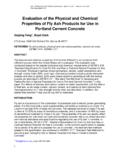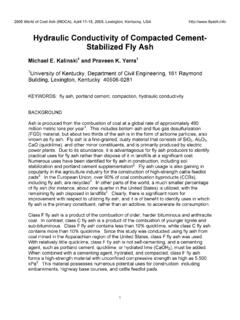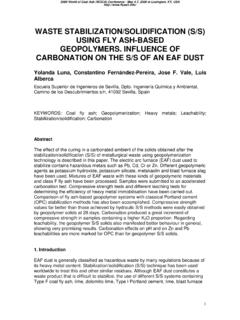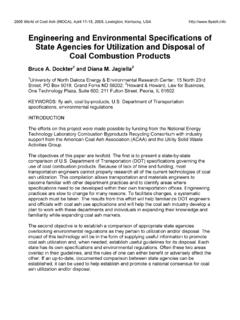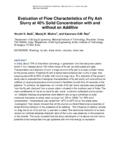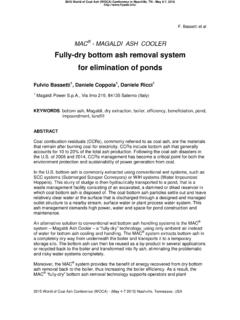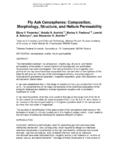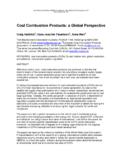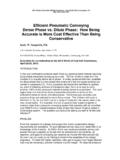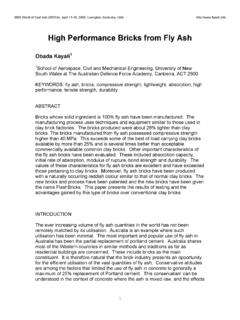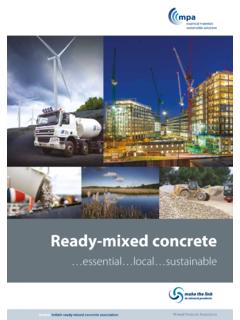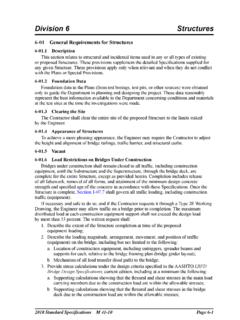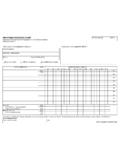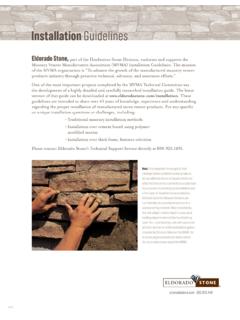Transcription of Class C Mixtures as Alternates to Portland-cement …
1 Class C Mixtures as Alternates to Portland-cement - based Foundation concrete William S. Caires, , Stan Peters, 1 Cesare & Associates, , 7108 South Alton Way, Building B, Centennial, CO 80112-2109, Castle Rock Consultants, LLC, 536 East 2nd Avenue, Castle Rock, CO 80108-9224, KEYWORDS: Class C, fly ash, portland cement alternatives, foundation concrete INTRODUCTION After completing mix development work for our Denver-client Flashfill Services, LLC utilizing foamed flashfill to mitigate frost-heave potential in street patches, we directed our attention towards fly ash products and markets for Flashfill Services and sister-company MK1 Construction Services, LLC in San Antonio, Texas. We focused our attention towards an alternate to portland cement based concrete Mixtures that could be used on-site in just-in-time production via volumetric mixing trucks for drilled-shaft caissons and foundation walls. These applications require no hand-finishing, are typically not exposed to freeze-thaw durability issues that would require air-entrainment, and aesthetics are not an issue.
2 Strength, sulfate-durability, and workability are the typical prime considerations. Estimating and supplying the specific quantity of ready-mixed concrete needed for an on-going caisson drilling project can be a challenge. Add to the challenge the issues with the scheduling and coordination of trucks matching expected production rates and traffic issues (on the road and at the project). Often too much concrete is on-site, exceeding drilling production, therefore compromising concrete quality and acceptability. Conversely, concrete delayed in traffic puts site production at risk while crews wait for deliveries. The issues are compounded when groundwater is encountered. In the end, reliably matching concrete production and delivery to on-site production needs would vastly improve efficiency, quality and safety. The issue of concrete rejection due to time is eliminated as well. Imagine the normal project site congested by equipment, materials and personnel.
3 Add to it the need to continually move concrete trucks in and out during drilled shaft and foundation wall construction. Now envision a single volumetric mixing truck parked near the concrete pump truck all day long. Water provided with a connection to a nearby fire-hydrant and Class C fly ash continuously supplied by pneumatic pump from one or more bulk powder trailers. Again, reliably matching concrete production and delivery to on-site production needs would vastly improve efficiency, quality and safety. The issue of concrete rejection due to time is eliminated as well. 2011 World of Coal Ash (WOCA) Conference - May 9-12, 2011 in Denver, CO, USA Services trucks have a continuous production rate of 50 to 60 CY/hour. For a conventional volumetric mixing truck, a single-aggregate, concrete alternative has been developed; on-site production would be augmented with a small front-end loader and a stock-pile of material. In this configuration, a portable aggregate stockpile (a specially-sized, open-ended roll-off dumpster) would allow aggregate deliveries throughout the day, with no stockpile loss or aggregate contamination.
4 A similar process for foundation walls could be implemented. BACKGROUND Recognition is given to Doug Cross, Jerry Stephens, and Mike Berry at the Western Transportation Institute at Montana State University for their 2009 article in Ash at Work (1). They described a demonstration project where recycled glass was used as the aggregate, and the Class C concrete was batched through a conventional batch plant and delivered with drum-mixing trucks, with all of the associated challenges. Their earlier work with Class C Mixtures used traditional sand and gravel as the aggregates (2). OBJECTIVES AND DESCRIPTIONS OF TWO concrete Mixtures Generally, the objectives for on-site mixed concrete to be suitable for caisson and foundation construction would be a compressive strength readily meeting specified strengths of 4000psi, a workable slump of 6-10 and two hours or more time prior to flashing. ACI 318-08 Table requires an over-design of 1200psi for 4000psi specified strength concrete when no field data of production is available.
5 Our testing indicated the Class C Mixtures readily met the ACI 5200psi strength requirement (4000 psi specified + 1200 psi over-design). Mixture 1 incorporated 2950lb/cy of Class C fly ash, (from Xcel s Pawnee Power Station, located northeast of Denver, near Brush, Colorado), water and Borax ( Borax by dry weight of the fly ash). The water-fly ash ratio was , culminating in a 9 slump. The addition of Borax at retarded the flash so as to provide ample time to mix, test physical properties, fabricate specimens and have a civilized clean-up . It should be noted that an earlier test batch lacked sufficient Borax to retard the flash-set resulting in time required to chip out the laboratory mixer. We developed this paste-only mixture to evaluate its engineering properties and determine if such a mix could be used in a structural application. On a side note, we found that the laboratory mixed mixture without aggregates required additional mixing effort utilizing a drill-powered mixing-paddle to homogenize and break down cementitious clumps.
6 Homogenizing and breaking down cementitious clumps should be readily accomplished in volumetric mixing trucks with aggressive mixing augers. FlashCrete with a 9 Slump Mixture 2 included Pawnee s fly ash as discussed above and a by-product of local sand and gravel processing known locally as sgueegee. Squeegee is nominally sized as1/4 by 1/8 when processed, creating a #4 by #16-sized product. It is too fine for gravel and too coarse for concrete sand. It typically meets an ASTM C33 #9 grading. Similar aggregate by-products are available around the country known by different local names. Due to its abundance and low cost, it was intended as an economical means to reduce paste quantity without attempting aggregate-packing optimization. Dry-rodded unit-weight testing indicated that 2700lb/cy was the maximum theoretical amount that could be used. Previous test batches incorporated 2000lbs and 2500lbs of this aggregate. The 2000lb/cy mixture had more fluidity than needed, whereas the 2500lb/cy mixture was too harsh to place without vibration.
7 Thus, the final mixture tested and reported below contained 2200lb/cy of squeegee, representing 50% of the volume of the Class C concrete . This mixture was batched at a w/fa ratio and achieved a 9 slump. FlashCrete with 2200lb of Squeegee, with a more traditional-looking 9 slump LABORATORY MIXING & TESTING The two Mixtures described above were batched on January 29, 2011. Fresh property testing was conducted and specimens for ASTM C39 (compressive strength), ASTM C496 (split-tensile strength), ASTM C1202 (rapid-chloride permeability) and ASTM C157 (drying-shrinkage) were fabricated. Testing was conducted in association with and by Cesare/CTS, an AASHTO-accredited laboratory. Additional compressive strength specimens incorporating a local cement product at & w/c ratios, and Pawnee at and w/fa ratios were also cast for comparison purposes. Specimens for sulfate resistance testing by ASTM C452 and C1012 were fabricated and tested at JAC/CTS s laboratory.
8 The fresh unit weights for the FlashCrete and FlashCrete with Squeegee were and , respectively. Air-contents measured for the FlashCrete and for the FlashCrete with Squeegee. Neither mixture was air-entrained, so the measured air contents are surmised to represent entrapped air due to mixing. COMPRESSIVE STRENGTHS The C39 compressive strengths for the Mixtures discussed are summarized in the table below, and shown graphically for comparison. Material Pawnee Class C Pawnee Class C & SQ Pawnee Class C Pawnee Class C Holcim cement Holcim cement Mix ID FC FC-2200SQ w/cm 1-day 2540 2490 900 300 1380 1050 3-day 3890 4270 1060 800 4560 3710 7-day 4620 4870 1330 990 6430 5440 28-day 5710 6190 2015 1480 9560 8040 Strength Gain vs. Time010002000300040005000600070008000900 010000051015202530 Age (days)Compressive Strength (psi)Pawnee FC, w/cmPawnee FC-2200SQ, w/cmPawnee, w/cmPawnee, w/cmHolcim, w/cmHolcim, w/cm Comment: The 1-day strengths with Class C concrete at about a w/fa ratio are approximately 2500psi.
9 Past results with Class C fly ashes with little or no Borax yielded approximately 3000psi in one day. The high early strength development could provide for an advantage in stripping and advancing forms when compared to normal cement - based concrete , unless accelerators are used. The three day strengths of the Class C concrete Mixtures were comparable to the cement -paste strengths tested, whereas the cement had greater strengths at both 7 and 28 days. It should be noted that the Class C Mixtures tested readily met the intended design strength of 4000psi for caisson and foundation concrete at 7-days and significantly exceeded those requirements at 28 days. Fly ash is often used as a cement replacement in concrete Mixtures subject to specified or practical limitations of the amounts of fly ash replacing the cement . The tested Class C fly ashes typically achieve approximately 6000psi at 28 days with a w/fa ratio of about One Class C fly ash (not presented herewith) from Texas achieved over 7100psi at 28 days with a w/fa ratio of The Class C fly ashes tested have adequate workability at to w/fa ratios and strengths sufficient for normal structural concrete of 4000psi.
10 However, these same fly ashes perform poorly, when forced to operate at typical Portland-cement driven w/c ratios of and More discussion provided in our conclusions. SULFATE RESISTANCE TESTING The sulfate resistance of Class C fly ash concrete is being evaluated by two methods. First, ASTM C1012, the industry standard for cement & fly ash combinations for sulfate resistance testing is underway. While the results to date are similar to initial values of typical cements meeting the ACI-318 limits of Table , it is premature to make a conclusion based on our early age findings. Second, ASTM C452 testing was employed. Mortar bars with fly ash alone and fly ash with silica classified #C109 ASTM #C778 graded sand (standard sand) were mixed with sufficient high-grade natural gypsum to achieve a SO3 as specified in C452. Bars fabricated without sand exhibited negligible expansions with measurements of at 14 days; whereas, by comparison, the specimens with sand expanded Both results meet the requirement in ASTM C150 for Type V cement tested by ASTM C452 of no greater than expansion in 14 days.
